As I gently ran my hand over my growing belly, I couldn’t help but notice my breasts were changing. They had gotten bigger and were quite tender. These signs showed me my body was getting ready for motherhood, thanks to huge hormonal changes.
When you’re pregnant, your hormones go wild. They hugely impact your breasts – making them grow, change shape, and prepare for lactation. Estrogen, progesterone, and prolactin are key. Estrogen boosts breast duct cell growth and prolactin making, leading to bigger breasts. Progesterone helps with milk cell formation. After birth, more prolactin kicks in, meaning it’s time for milk and breastfeeding.
From pregnancy’s start, your body goes through major physical changes. Your breasts will swell, ache, and get ready to feed your baby. Every woman’s journey is different, but one thing stands true: these changes get your breasts ready for their nourishing job.
Key Takeaways
- Pregnancy hormones like estrogen, progesterone, and prolactin drive significant changes in breast size and appearance.
- Estrogen stimulates breast duct cell growth and prolactin production, leading to breast enlargement.
- Progesterone supports the development of milk-producing cells within the breasts.
- Hormonal shifts during and after pregnancy prepare the breasts for lactation and breastfeeding.
- Breast changes can vary widely between pregnant women, but the underlying physiological processes are the same.
Breast Changes During Early Pregnancy
Once a woman is pregnant, her body starts changing fast. This change is first seen in her breasts, sometimes just 1-2 weeks after she got pregnant. This early change happens because her hormone levels – like estrogen, progesterone, and prolactin – are shifting quickly. These hormones are getting the breasts ready for breastfeeding.
Breast Swelling and Tenderness
Early pregnancy often brings swelling, soreness, and tenderness in the breasts. This happens because of the boost in progesterone. It makes the cells that produce milk grow. So, the breasts will feel bigger, heavier, and very sensitive.
Feeling of Heaviness or Fullness
Many women also say their breasts feel heavy or full early in pregnancy. This is the body’s way of preparing for breastfeeding. The breasts start to grow to be ready for the baby’s needs.
Differentiating from PMS Symptoms
Feeling breast swelling, tenderness, or heavy can seem like PMS. But, it’s not the same. The difference is in the hormones. During pregnancy, it’s the high progesterone levels causing these changes. The good news is, these discomforts often lessen in a few weeks. That’s when the body gets used to the new hormonal state.
First Trimester Breast Changes
Early pregnancy brings big hormonal changes. This means your breasts can transform a lot. As your body prepares to nurture a baby, you might see blue, larger veins under your skin. This happens because your breasts need more blood flow.
Your breasts grow and your nipples may get bigger and more sensitive. The area around your nipples, called areolas, could also get darker. All these changes happen because your body is getting ready for pregnancy.
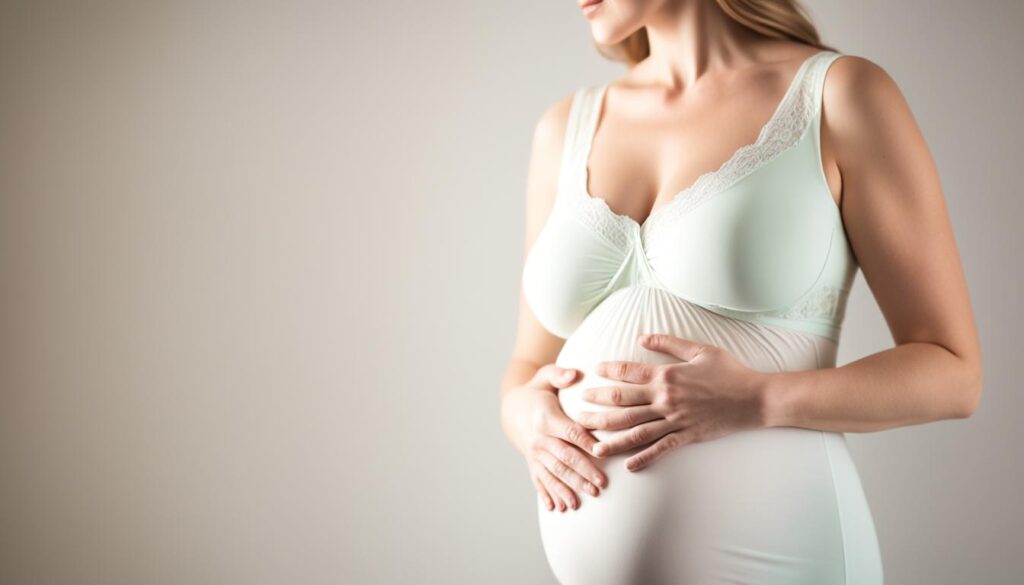
Second Trimester Breast Transformations
In the second trimester of pregnancy, your body keeps changing. Breasts, especially, show big differences. The darkening of the areolas stands out. These areas get darker thanks to higher estrogen levels.
Areola Darkening
The more estrogen your body makes, the darker your areolas get. This is good preparation for breastfeeding. It makes the nipple and areola colmplex easier to see and use for the baby.
Montgomery’s Tubercles Development
Simultaneously, you may notice Montgomery’s tubercles. These appear as small bumps on the areolas. They help keep your breasts safe and well-lubricated for when you start to breastfeed.
Colostrum Production and Leakage
Aside from areola changes, your breasts might start making colostrum. This first milk is rich with nutrients for your baby. Sometimes, it might leak, showing you are getting ready to feed your baby.
All these changes are because of the many hormones surging in your body during the second trimester.
How do hormonal changes during pregnancy affect breast size?
During pregnancy, hormones estrogen, progesterone, and prolactin lead to bigger and different-looking breasts. They prep the breasts for feeding the baby. This change is natural and vital for baby’s nutrition.
Estrogen’s Role in Breast Growth
Estrogen mainly makes the breasts bigger during pregnancy. It makes the breast duct cells grow. This action allows the breasts to get larger. Estrogen also helps with prolactin production, which is important for breastfeeding.
Progesterone’s Impact on Milk-Producing Cells
Progesterone helps make the milk-producing cells grow in the breasts. It works along with estrogen. This prepares the mammary glands for making milk after the baby is born.
Prolactin’s Influence on Breast Enlargement
Prolactin boosts breast growth further after estrogen has started the process. It works on the milk-producing alveolar cells. This ensures the breasts get bigger throughout pregnancy. These changes make sure the breasts are set for feeding the baby.
During pregnancy, high levels of estrogen, progesterone, and prolactin make the breasts bigger. They get ready to feed the newborn. This growth in breast size is a critical part of preparing for motherhood.
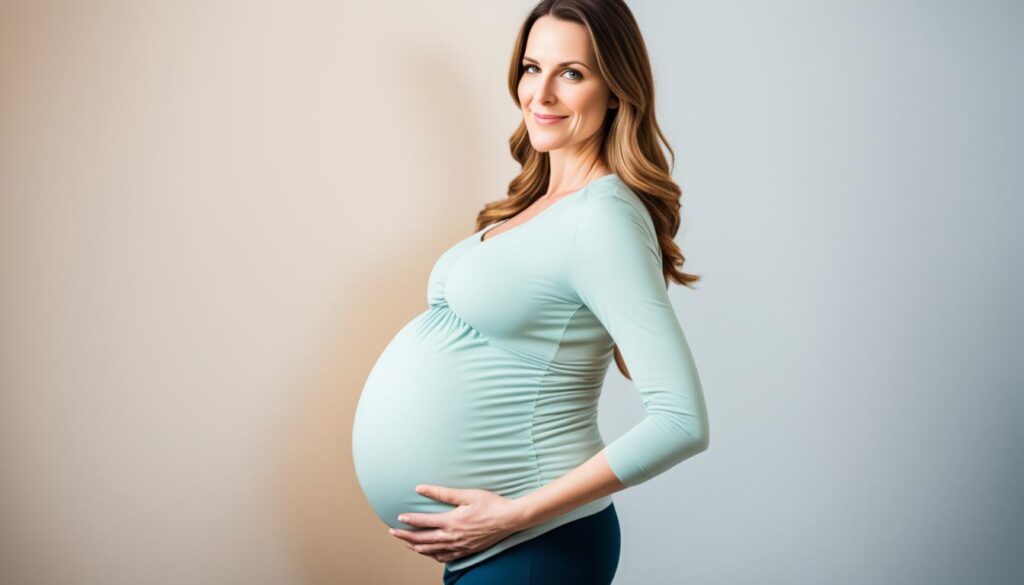
Third Trimester Breast Alterations
In the final trimester of pregnancy, moms-to-be see their breasts changing a lot. This happens as the body gets ready for feeding the baby. So, third trimester breast changes are a natural part of preparing for motherhood.
Continued Breast Enlargement
Breasts grow heavier and denser in the last months of pregnancy. They’re getting bigger to supply the baby’s needs. This continued breast enlargement is due to hormonal changes in the body.
Nipple Prominence and Darkening
In the third trimester, nipples can become more prominent and darker. This is because the body is preparing for breastfeeding. So, you might notice your nipples get larger and turn a deeper color.
Skin Stretching and Potential Stretch Marks
The rapid growth of breasts can stretch the skin, which might feel uncomfortable. This stretching can also lead to stretch marks. Using moisturizing creams can help reduce discomfort.
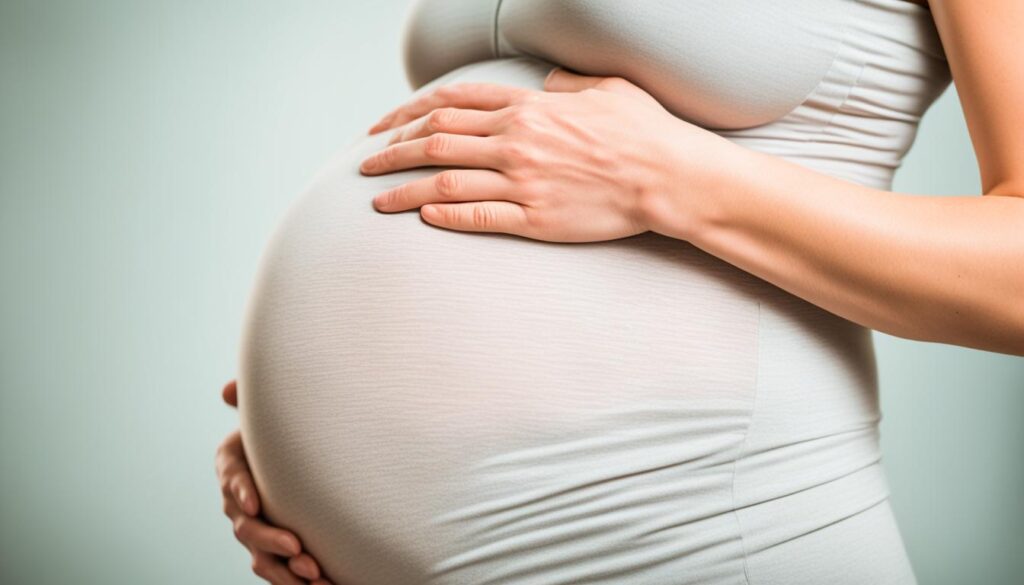
Bra Needs During Pregnancy
As my breasts grow during pregnancy, finding the right bra is vital for comfort and support. Soft, stretchy pregnancy bras with no underwire are great. They have wide straps and bands to offer support without the squeeze.
Choosing Comfortable and Supportive Bras
Focusing on comfortable pregnancy bras is crucial for me. I search for styles that adjust to my changing size. They must also provide the needed support. Wide, cushioned straps and bands make the load light, avoiding marks or irritations.
Sleep Bras for Nighttime Comfort
I also use sleep bras for night comfort. These wire-free styles keep me snug and prevent any nighttime discomfort. They are soft and designed for gentle support.
Nursing Bras for Breastfeeding Preparation
Thinking of after the baby arrives, I’m checking out nursing bras early. Finding ones that fit and work well now is smart. It will make breastfeeding easier later on.
Choosing comfortable and supportive pregnancy bras matters. Adding sleep and nursing bras helps. This way, I can make sure my breasts stay happy and healthy through this unique time.
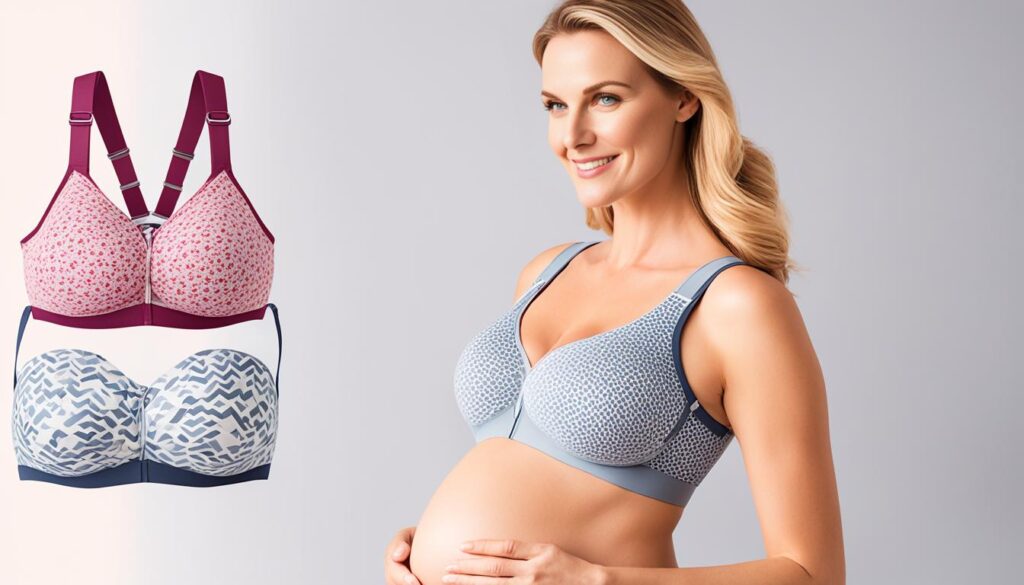
Breast Changes After Childbirth
After having a baby, breasts stay big because milk production starts. If breasts make more milk than the baby needs, women might feel breast engorgement. This makes the breasts feel firm, heavy, and uncomfortable.
Engorgement and Milk Production
Breasts can get too full as the body gets used to breastfeeding. This is called breast engorgement. It makes the breasts feel swollen, hard, and sore. Expressing milk by nursing or pumping can reduce this pain and help control milk supply.
Potential for Breast “Snap Back”
After breastfeeding ends, some women see their breasts go back to normal. This is known as the “snap back.” But, some might find their breasts stay bigger or less elastic.
Factors Affecting Breast Appearance Changes
The way breasts change in size and shape can vary. It depends on how long you breastfeed, your genetics, and if there were big weight changes during and after pregnancy.

Managing Breast Discomfort During Pregnancy
During pregnancy, you might find your breasts feeling sore and tender. This is very normal. Luckily, there are ways to make it more bearable. One way is to use breast pads for leakage. They’re great for absorbing colostrum or milk that might leak. With these pads, you can stay dry and confident all day.
But that’s not the only thing you can do. You can also apply moisturizers and oils to your breasts. This helps with any itchiness or dryness. These products can make your skin feel better. And gently massaging them in can help improve blood flow. It feels really nice on your skin.
If you get a blocked milk duct, there are ways to deal with it. Using warm towels on your breast and gently massaging can help. If the problem doesn’t go away, talking to a doctor or a lactation consultant is a good idea. They can give you the best advice for your situation.
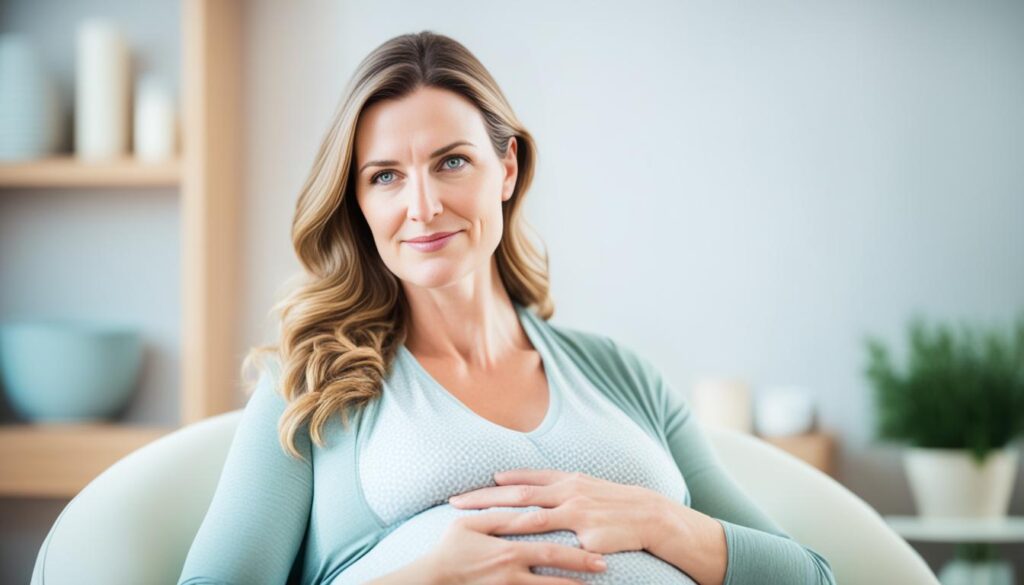
Breast Anatomy and Physiology
The mature breast anatomy is mainly fatty tissue. It includes lobes that are made for producing milk. These lobes lead to ducts, which carry milk to the nipple area. When a woman is pregnant, her breast changes a lot. The ductal system grows with the help of estrogen. This hormone also tells the pituitary gland to release prolactin. Prolactin is important because it starts milk production.
Breast Structure and Components
The breast structure includes fat, ducts, and glands that make milk. All these parts come together to prepare the breast for lactation.
Hormonal Interactions During Pregnancy
When a woman is pregnant, her body goes through huge hormonal changes. High estrogen levels reduce the fatty tissue but make the ductal system bigger. Around the 20th week of pregnancy, the mammary glands are ready to make colostrum. Colostrum is the first milk a baby gets.
Milk Production and Lactation Physiology
After giving birth, estrogen and progesterone levels drop. This drop is crucial for starting milk production and breastfeeding. It’s all thanks to prolactin. Prolactin makes the mammary glands produce and release milk for the baby.
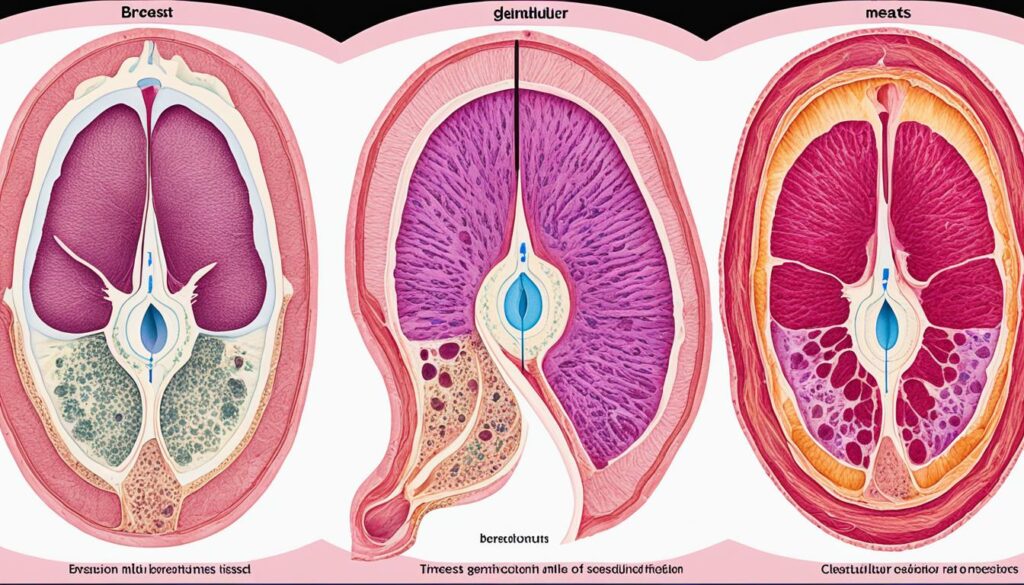
Variations in Breast Changes
During pregnancy, I’ve seen how different breast changes can be. Some people may not see all signs, like big size or darker areolas. It’s amazing to note the difference in breast changes among women.
Individual Differences in Breast Alterations
Breast swelling varies from one woman to another. While some notice big changes, others see only small differences. The growth in breast tissue and changes in nipples and areolas change from person to person. This happens due to things like genes, hormones, and the unique makeup of breasts.
Not a Predictor of Breastfeeding Ability
It’s interesting, but big breast changes are not a sign of how well someone can breastfeed. The looks of breasts during pregnancy do not show if a woman will make enough milk or breastfeed well. Not having many changes doesn’t mean there will be problems breastfeeding.
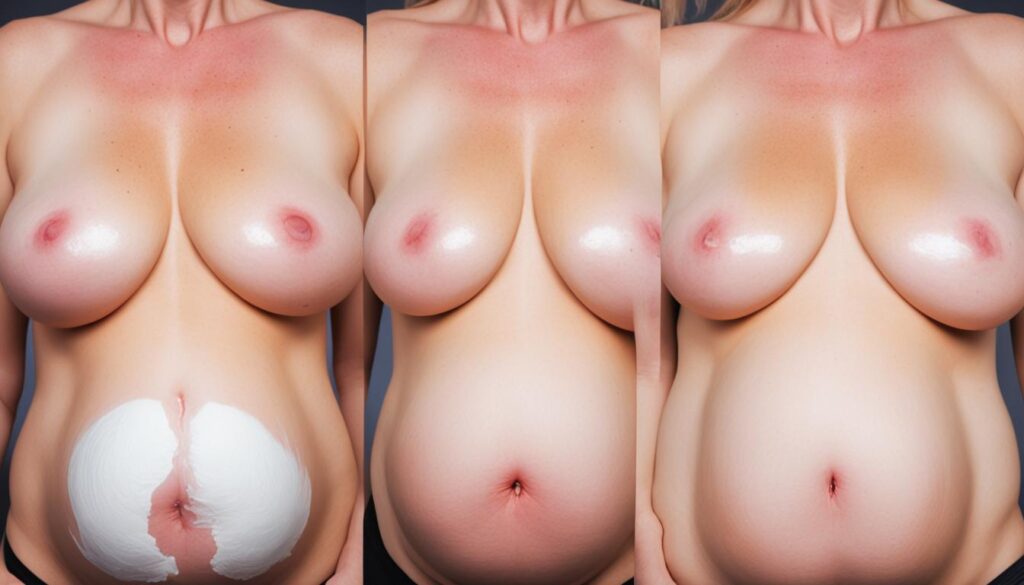
Getting the idea of individual differences in breast changes is key during pregnancy. Even when changes are big, they don’t say everything about your breastfeeding ability. Each pregnancy is its own, and we should remember that everyone’s body is unique.
Conclusion
Pregnancy is a unique journey filled with remarkable changes due to hormones. The breasts, in particular, go through significant changes, becoming larger and ready for lactation. These changes differ for each woman but are part of a common experience.
It’s crucial to note that a woman’s ability to breastfeed isn’t linked to how much her breasts change. The human body’s capacity to feed and nurture a baby is incredible. Let’s remind ourselves of the beauty of motherhood and the female body.
A woman’s true strength shines in her loving and nurturing role. Let’s cherish the special path each woman takes in pregnancy. The beauty of the maternal journey is found in the resilience and love a mother offers to her child.
